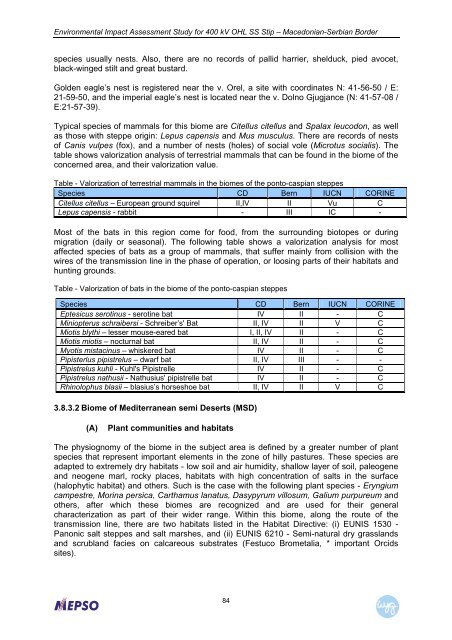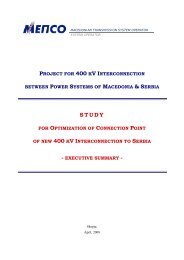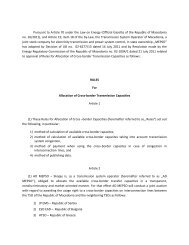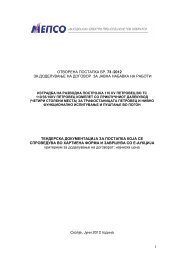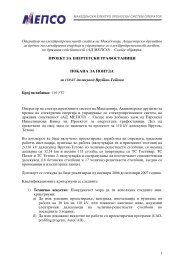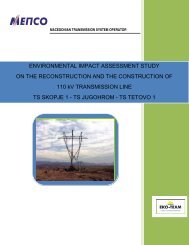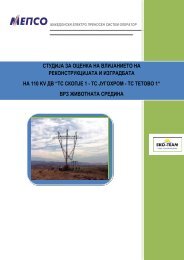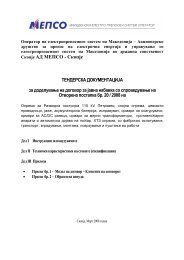Part A - EIA 400 kV OHTL Stp - мепÑо а.д.
Part A - EIA 400 kV OHTL Stp - мепÑо а.д.
Part A - EIA 400 kV OHTL Stp - мепÑо а.д.
Create successful ePaper yourself
Turn your PDF publications into a flip-book with our unique Google optimized e-Paper software.
Environmental Impact Assessment Study for <strong>400</strong> <strong>kV</strong> OHL SS Stip – Macedonian-Serbian Borderspecies usually nests. Also, there are no records of pallid harrier, shelduck, pied avocet,black-winged stilt and great bustard.Golden eagle’s nest is registered near the v. Orel, a site with coordinates N: 41-56-50 / E:21-59-50, and the imperial eagle’s nest is located near the v. Dolno Gjugjance (N: 41-57-08 /E:21-57-39).Typical species of mammals for this biome are Citellus citellus and Spalax leucodon, as wellas those with steppe origin: Lepus capensis and Mus musculus. There are records of nestsof Canis vulpes (fox), and a number of nests (holes) of social vole (Microtus socialis). Thetable shows valorization analysis of terrestrial mammals that can be found in the biome of theconcerned area, and their valorization value.Table - Valorization of terrestrial mammals in the biomes of the ponto-caspian steppesSpecies CD Bern IUCN CORINECitellus citellus – European ground squirel II,IV II Vu CLepus capensis - rabbit - III lC -Most of the bats in this region come for food, from the surrounding biotopes or duringmigration (daily or seasonal). The following table shows a valorization analysis for mostaffected species of bats as a group of mammals, that suffer mainly from collision with thewires of the transmission line in the phase of operation, or loosing parts of their habitats andhunting grounds.Table - Valorization of bats in the biome of the ponto-caspian steppesSpecies CD Bern IUCN CORINEEptesicus serotinus - serotine bat IV II - CMiniopterus schraibersi - Schreiber’s' Bat II, IV II V CMiotis blythi – lesser mouse-eared bat I, II, IV II - CMiotis miotis – nocturnal bat II, IV II - CMyotis mistacinus – whiskered bat IV II - CPipisterlus pipistrelus – dwarf bat II, IV III - -Pipistrelus kuhli - Kuhl's Pipistrelle IV II - CPipistrelus nathusii - Nathusius' pipistrelle bat IV II - CRhinolophus blasii – blasius’s horseshoe bat II, IV II V C3.8.3.2 Biome of Mediterranean semi Deserts (МSD)(A)Plant communities and habitatsThe physiognomy of the biome in the subject area is defined by a greater number of plantspecies that represent important elements in the zone of hilly pastures. These species areadapted to extremely dry habitats - low soil and air humidity, shallow layer of soil, paleogeneand neogene marl, rocky places, habitats with high concentration of salts in the surface(halophytic habitat) and others. Such is the case with the following plant species - Eryngiumcampestre, Morina persica, Carthamus lanatus, Dasypyrum villosum, Galium purpureum andothers, after which these biomes are recognized and are used for their generalcharacterization as part of their wider range. Within this biome, along the route of thetransmission line, there are two habitats listed in the Habitat Directive: (i) EUNIS 1530 -Panonic salt steppes and salt marshes, and (ii) EUNIS 6210 - Semi-natural dry grasslandsand scrubland facies on calcareous substrates (Festuco Brometalia, * important Orcidssites).84


